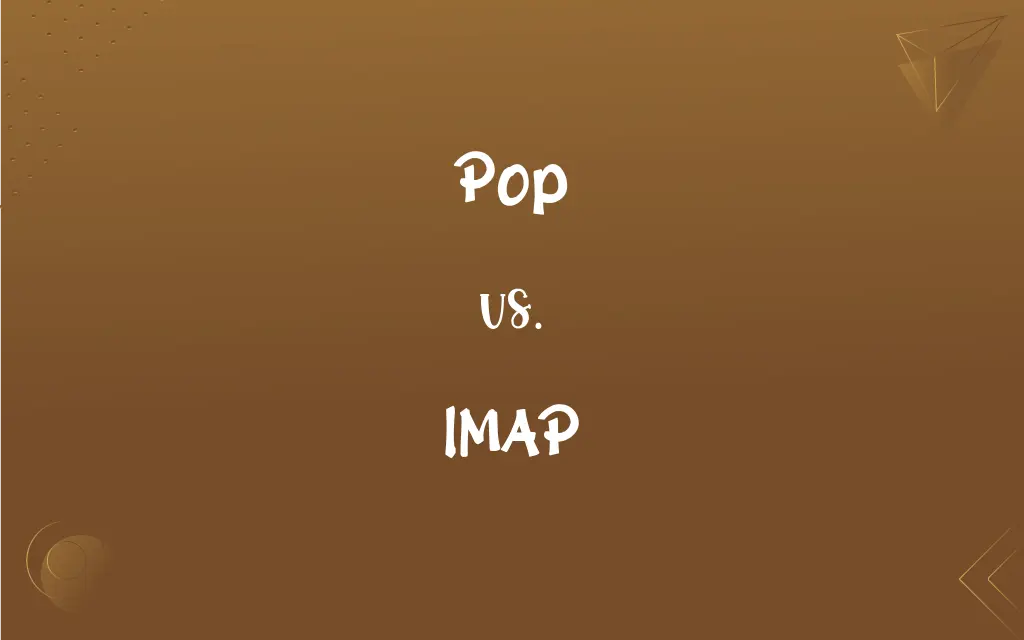POP vs. IMAP: What's the Difference?
Edited by Janet White || By Harlon Moss || Updated on October 26, 2023
POP retrieves mail, IMAP syncs mail.

Key Differences
POP (Post Office Protocol) and IMAP (Internet Message Access Protocol) are both protocols used to retrieve emails from a server. POP downloads emails to a single device and deletes them from the server, whereas IMAP leaves messages on the server and synchronizes across multiple devices.
With POP, once you download your email, it's typically removed from the mail server. IMAP, on the other hand, stores email on the server, allowing you to view and manage those emails from various devices and locations.
POP tends to work best for those who access their email from a single device. IMAP is better suited for those who need to access their email from multiple devices or locations, as it keeps everything synchronized and up-to-date.
In summary, POP is about downloading and removing, making it less flexible for multi-device users, while IMAP is about syncing and keeping, offering greater flexibility and consistency across devices.
Comparison Chart
Primary Function
Downloads emails from server to device
Synchronizes emails across devices
ADVERTISEMENT
Message Storage
Typically removes from server after download
Retains on server
Multi-device Access
Limited, as messages get downloaded and removed
Flexible, emails are synchronized
Internet Requirement
Required only for downloading
Required for viewing/synchronizing
Best Suited For
Single device users
Multiple device users
POP and IMAP Definitions
Pop
A sudden short sound.
I heard a pop from the balloon.
ADVERTISEMENT
IMAP
IMAP (Internet Message Access Protocol) is a standard protocol used by email clients to retrieve messages from a mail server.
Using IMAP, she could sync and access her emails from multiple devices without any discrepancies.
Pop
A type of popular music.
She's listening to the latest pop song.
IMAP
IMAP, as an acronym in medical research, might refer to 'Immunomodulatory Associated Proteins' – proteins that play a role in regulating the immune response.
The study shed light on how certain IMAPs can be targeted for autoimmune disease treatments.
Pop
To go or come suddenly.
He just popped into my office unexpectedly.
IMAP
IMAP (Immediate Mapping) refers to direct correspondence between two sets of data.
The software establishes an IMAP between user actions and on-screen feedback.
Pop
Short for "father" or "dad" in informal speech.
I'll ask Pop if I can go.
IMAP
IMAP, in the context of functional programming, is an abbreviation for 'Iterative Map' - a way to apply a function iteratively to each element in a list.
He used IMAP to transform every element of the list without writing a loop.
Pop
To open something quickly.
She popped the can open.
IMAP
IMAP, in the domain of geospatial analysis, can refer to an interactive map displaying dynamic data.
The city's IMAP offers real-time traffic updates for commuters.
Pop
To make a short, sharp, explosive sound.
FAQs
What is the main function of POP?
POP's main function is to download emails from the server to a single device.
Can I access my POP emails from another device?
Once downloaded, POP emails are typically not available for access from other devices.
Do I always need an internet connection to view IMAP emails?
You need an internet connection to synchronize and view new IMAP emails, but previously synchronized emails can be viewed offline.
Is POP best for single or multiple device users?
POP is best suited for single device users.
What does POP stand for in email context?
POP stands for Post Office Protocol.
Is one protocol more secure than the other?
Security depends more on the implementation and the email service rather than the protocol itself. Both can be secure if properly configured.
How does IMAP handle emails on the server?
IMAP leaves messages on the server and synchronizes them across multiple devices.
What happens if I delete an email on one device using IMAP?
If you delete an email on one device using IMAP, it will typically be deleted across all synchronized devices.
What happens if I read an email on one device using IMAP?
If you read an email on one device using IMAP, it will be marked as read across all synchronized devices.
Is IMAP better for single or multiple device users?
IMAP is better suited for multiple device users.
How many versions of POP are there?
There have been several versions, with POP3 being the most widely used.
Can I use both POP and IMAP simultaneously for the same email account?
It's technically possible, but not recommended as it can lead to inconsistencies in email management.
Does POP remove emails from the server?
Typically, yes, POP removes emails from the server once downloaded.
What does IMAP stand for?
IMAP stands for Internet Message Access Protocol.
How is POP different from IMAP in email storage?
POP usually downloads and removes emails from the server, while IMAP retains emails on the server.
Which protocol is older, POP or IMAP?
POP is older than IMAP.
Will using IMAP fill up my email server storage quickly?
Since IMAP retains emails on the server, it might fill up storage faster than POP, depending on your email usage.
Which protocol is more popular today, POP or IMAP?
IMAP is more popular today due to its flexibility and synchronization features.
Do all email services support both POP and IMAP?
Most modern email services support both POP and IMAP, but always check with your provider.
Can I switch from POP to IMAP?
Yes, you can switch from POP to IMAP, but it might require setting up your email account anew and migrating emails.
About Author
Written by
Harlon MossHarlon is a seasoned quality moderator and accomplished content writer for Difference Wiki. An alumnus of the prestigious University of California, he earned his degree in Computer Science. Leveraging his academic background, Harlon brings a meticulous and informed perspective to his work, ensuring content accuracy and excellence.
Edited by
Janet WhiteJanet White has been an esteemed writer and blogger for Difference Wiki. Holding a Master's degree in Science and Medical Journalism from the prestigious Boston University, she has consistently demonstrated her expertise and passion for her field. When she's not immersed in her work, Janet relishes her time exercising, delving into a good book, and cherishing moments with friends and family.































































